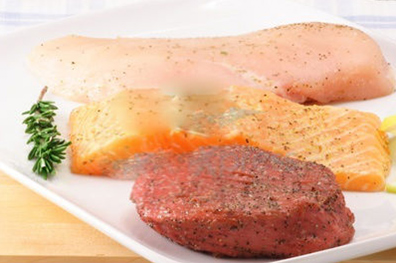Nutrition Derived From Beef Which Is Good for Muscle Development

To build muscle, there is no nutrient more necessary than protein. It also aids fat loss by promoting satiety, or feelings of fullness, and helps spare muscle tissue in the face of a reduced-calorie nutrition plan.
Beef, chicken, and fish are all excellent sources of protein and are carb free or low carb1, and consuming protein from a variety of sources is ideal. All animal proteins are complete, which means your body cannot make the nutrients you receive yourself.
Still, depending on your goals, medical issues, and body type, some may be more beneficial than others, but this has more to do with the fat (and calorie) content than the actual source of protein.
1. Beef
Beef comes from cows and generally has the more fat that chicken or fish. The make-up of fat in beef varies with how the cows are fed. Compared to grain fed, grass-fed beef has less overall fat but a higher percentage of omega-3 fatty acids, which are anti-inflammatory and can help build muscle and burn fat.
The leanest cuts of beef are:
- Sirloin tip side steak (5.4 grams of fat per 3.5 ounce serving)
- Eye of round roast or steak (7 grams of fat per 3.5 ounce serving)
- Top round roast and steak (7.6 grams of fat per 3.5 ounce serving)
- Top sirloin steak (10.6 grams of fat per 3.5 ounce serving)
- Bottom round roast and steak (11 grams of fat per 3.5 ounce serving)
The fattiest cuts of meat are rib-eye (37.6 grams of fat) and T-bone (25.6 grams of fat) steaks. I looked at many nutrition data sites, including the USDA's, and found a great variation in the amount of fat in filet mignon, which many people think is a very lean cut. Fat content ranged from just 3 grams per serving to more than 15 grams.
2. Chicken
White meat chicken is low in fat and high in protein. Like filet mignon, I found many different nutritional profiles, with fat content ranging from 1 gram to 6 grams per 4 ounces of skinless breast. Skinless dark meat chicken's fat content ranges from 6 to 12–plus grams per serving depending on the source of the nutrition data.
Chicken skin is mostly fat and eating the skin can quickly add unnecessary fat and calories to your nutrition plan. It is a better idea to skip the skin and get your fat from healthier sources like olive or coconut oil, nuts and avocado.
3. Fish
Fish is a very healthy protein choice. Fattier fish, generally from cold water, contain significant amounts of heart-healthy (and muscle-friendly) omega-3 fatty acids. Wild fish tend to have more favorable fat profiles than farm-raised fish, particularly salmon. However, higher fat content (even if it is the healthiest kind of fat) means higher calories, and if you're trying to lose body fat you must keep this in mind.
Certain kinds of fish can be high in toxins, particularly mercury, and you should generally avoid or limit intake from these sources. Larger fish at the top of the food chain, like big eye or Ahi tuna, swordfish, shark and king mackerel contain significant amounts of mercury. Smaller fish such as sardines are high in both protein and omega-3 fatty acids and low in toxins. Additionally, they are cheap and an environmentally-sound choice, as they are plentiful and reproduce quickly.
If you chose to eat canned tuna, light tuna contains less mercury than albacore. Canned salmon is a better option, though fat content can vary significantly depending on the kind of salmon. Canned pink salmon is high in protein, low in fat and contaminants, and relatively inexpensive. The Monterey Bay Aquarium maintains a list2 of the best and worst seafood choices based on environmental impact and contaminants. I recommend visiting the site for the "best" choices and then picking seafood from the list that contains the proper nutrient breakdown for your goals.
4. Game Meats
Game, like venison (deer), elk and bison tend to be lean and high in protein. However, they often come with a high price tag and can be difficult to cook. Overcooking lean protein results in a tough, unpalatable meal. Game meats can taste "gamey" if not prepared properly. Still, learning how to work with these protein sources can expand your options and be a welcome change to chicken and beef.
There Really Is No Best Protein – Choose Variety
Really, there is no "best" protein source for losing fat and building muscle. I recommend using a variety of sources and tailoring your choices to your body and your goals. For example, if you do better with a lower carbohydrate plan, then using protein sources with higher fat content may help you. If total calorie content is your main concern, you'll do better with the leanest protein choices but can potentially miss out on beneficial fats.
Like most things, a certain protein source can be good or bad depending on your circumstances. In all cases, moderation and common sense should be your guide, and all choices should be made within the context of a healthy lifestyle.
Source: https://www.builtlean.com/beef-chicken-fish-protein/
0 Response to "Nutrition Derived From Beef Which Is Good for Muscle Development"
إرسال تعليق